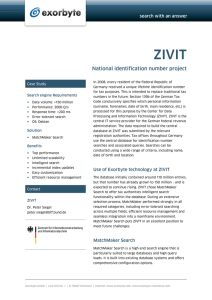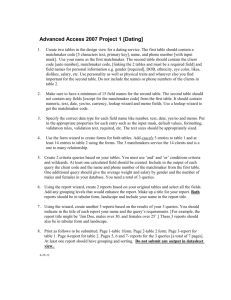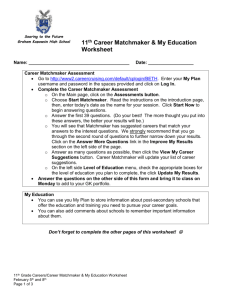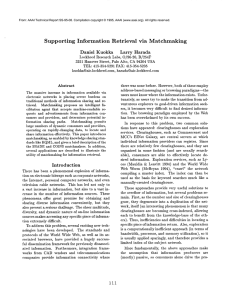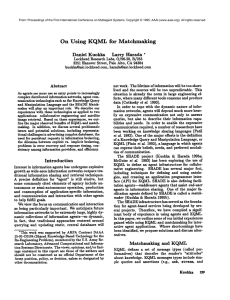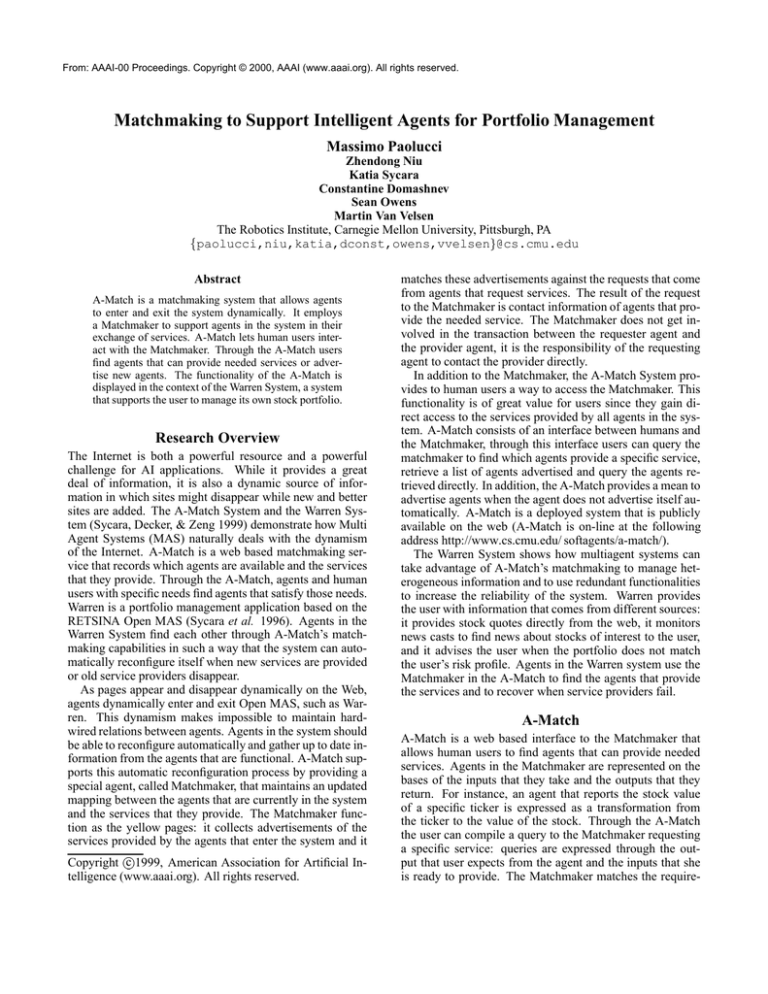
From: AAAI-00 Proceedings. Copyright © 2000, AAAI (www.aaai.org). All rights reserved.
Matchmaking to Support Intelligent Agents for Portfolio Management
Massimo Paolucci
Zhendong Niu
Katia Sycara
Constantine Domashnev
Sean Owens
Martin Van Velsen
The Robotics Institute, Carnegie Mellon University, Pittsburgh, PA
paolucci,niu,katia,dconst,owens,vvelsen @cs.cmu.edu
Abstract
A-Match is a matchmaking system that allows agents
to enter and exit the system dynamically. It employs
a Matchmaker to support agents in the system in their
exchange of services. A-Match lets human users interact with the Matchmaker. Through the A-Match users
find agents that can provide needed services or advertise new agents. The functionality of the A-Match is
displayed in the context of the Warren System, a system
that supports the user to manage its own stock portfolio.
Research Overview
The Internet is both a powerful resource and a powerful
challenge for AI applications. While it provides a great
deal of information, it is also a dynamic source of information in which sites might disappear while new and better
sites are added. The A-Match System and the Warren System (Sycara, Decker, & Zeng 1999) demonstrate how Multi
Agent Systems (MAS) naturally deals with the dynamism
of the Internet. A-Match is a web based matchmaking service that records which agents are available and the services
that they provide. Through the A-Match, agents and human
users with specific needs find agents that satisfy those needs.
Warren is a portfolio management application based on the
RETSINA Open MAS (Sycara et al. 1996). Agents in the
Warren System find each other through A-Match’s matchmaking capabilities in such a way that the system can automatically reconfigure itself when new services are provided
or old service providers disappear.
As pages appear and disappear dynamically on the Web,
agents dynamically enter and exit Open MAS, such as Warren. This dynamism makes impossible to maintain hardwired relations between agents. Agents in the system should
be able to reconfigure automatically and gather up to date information from the agents that are functional. A-Match supports this automatic reconfiguration process by providing a
special agent, called Matchmaker, that maintains an updated
mapping between the agents that are currently in the system
and the services that they provide. The Matchmaker function as the yellow pages: it collects advertisements of the
services provided by the agents that enter the system and it
Copyright c 1999, American Association for Artificial Intelligence (www.aaai.org). All rights reserved.
matches these advertisements against the requests that come
from agents that request services. The result of the request
to the Matchmaker is contact information of agents that provide the needed service. The Matchmaker does not get involved in the transaction between the requester agent and
the provider agent, it is the responsibility of the requesting
agent to contact the provider directly.
In addition to the Matchmaker, the A-Match System provides to human users a way to access the Matchmaker. This
functionality is of great value for users since they gain direct access to the services provided by all agents in the system. A-Match consists of an interface between humans and
the Matchmaker, through this interface users can query the
matchmaker to find which agents provide a specific service,
retrieve a list of agents advertised and query the agents retrieved directly. In addition, the A-Match provides a mean to
advertise agents when the agent does not advertise itself automatically. A-Match is a deployed system that is publicly
available on the web (A-Match is on-line at the following
address http://www.cs.cmu.edu/ softagents/a-match/).
The Warren System shows how multiagent systems can
take advantage of A-Match’s matchmaking to manage heterogeneous information and to use redundant functionalities
to increase the reliability of the system. Warren provides
the user with information that comes from different sources:
it provides stock quotes directly from the web, it monitors
news casts to find news about stocks of interest to the user,
and it advises the user when the portfolio does not match
the user’s risk profile. Agents in the Warren system use the
Matchmaker in the A-Match to find the agents that provide
the services and to recover when service providers fail.
A-Match
A-Match is a web based interface to the Matchmaker that
allows human users to find agents that can provide needed
services. Agents in the Matchmaker are represented on the
bases of the inputs that they take and the outputs that they
return. For instance, an agent that reports the stock value
of a specific ticker is expressed as a transformation from
the ticker to the value of the stock. Through the A-Match
the user can compile a query to the Matchmaker requesting
a specific service: queries are expressed through the output that user expects from the agent and the inputs that she
is ready to provide. The Matchmaker matches the require-
Figure 1: The Warren Architecture.
ments of the user against the advertisements stored and it
reports the list of agents whose advertisement matches the
request of the user. The match performed by the Matchmaker is based on a taxonomy of terms. For example, an
agent A might advertise that, given a ticker name, it reports
the value of the corresponding stock, while the user might
look for an agent that given a stock name returns the price of
the stock. The Matchmaker would recognize a similarity between ticker and stock name, and a similarity between value
and price and report to the user the agent A provides the service requested. Once an agent is found, the user can use the
A-Match to query the agent directly and display the answer
from the agent. Users can also use the A-Match to browse
the ontology used during the matching process. The browser
allows them to find the definition of terms, and to estimate
the similarity between terms in the ontology. In addition,
the A-Match provides functionalities that allow the user to
browse advertisements, advertise new agents, unadvertise
agents and update the advertisement of agents. The browse
functionality displays the list of all agents that already advertised with the Matchmaker; humans can advertise functionalities of agents that cannot advertise on their own; unadvertise is used to remove references of agents from the
matchmaker; while update is an editing facility that allows
the user to modify advertisements to correct mistakes.
A-Match can store different types of advertisements coming from different applications. Purposely, the Matchmaker
does not pose any boundary between applications: any agent
that matches the request can be suggested as provider of a
service. Ultimately, the same agent can provide a service in
two different systems provided that it responds to the needs
of those systems. This blurring of boundaries between systems is a very important feature for multiagent systems since
it allows automatic reusability of functionalities.
Warren
Warren shows how a multiagent system can take advantage
of the A-Match and the Matchmaker. As shown in figure
1, Warren is composed of three types of agents: interface
agents that display the portfolios to the users, task agents
that assist the user in the management of its portfolio, and
information agents that are used to gather information about
stocks in the portfolio. Through the interface agent the user
can buy stocks, sell stocks, monitor the value of its own portfolio and monitor news about the stocks in the portfolio. In
addition the user can monitor the value of prospective stocks
that she does not own yet. Two task agents assist the user,
the Comptroller records the portfolio and could interact with
brokers (At the moment though, Warren does not allow real
stock trading) to actually acquire stocks. The Risk Critic
acts as a financial advisor and signals to the user when the
acquisition of new stocks in the portfolio or the sale of some
stocks modifies the risk associated with the portfolio. Information agents monitor the web to report the value of stocks
and their current risk profile, so that the risk critic can suggest to the user whether to buy or sell. Furthermore, some
information agents monitor news casts to find news that can
be of interest for the user.
The interaction between agents is a key aspect of MAS,
but this interaction is very difficult to appreciate because it is
always hidden in the computation of the agents. The Retsina
MAS offers a tool, called Demo Display, that monitors and
graphically displays the agents and their exchange of messages.
Acknowledgments
The authors wish to acknowledge the contribution of many
people that through the years worked on different versions of
Warren. This research has been sponsored in part by ONR
grant N-00014-96-16-1-1222 by DARPA grant F-30602-982-0138.
References
Sycara, K.; Decker, K.; Pannu, A.; Williamson, M.; and
Zeng, D. 1996. Distributed intelligent agents. IEEE Expert,
Intelligent Systems and their Applications 11(6):36–45.
Sycara, K.; Decker, K.; and Zeng, D. 1999. Intelligent agents in portfolio management. In Agent Technology: Foundations, Applications, and Markets., eds., N. Jennings and M. Woolridge. Springer.

